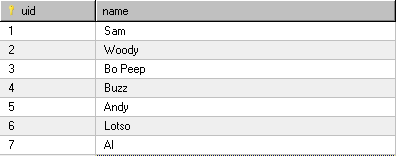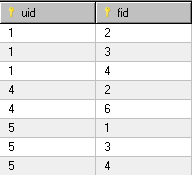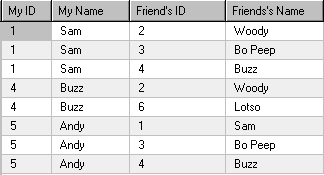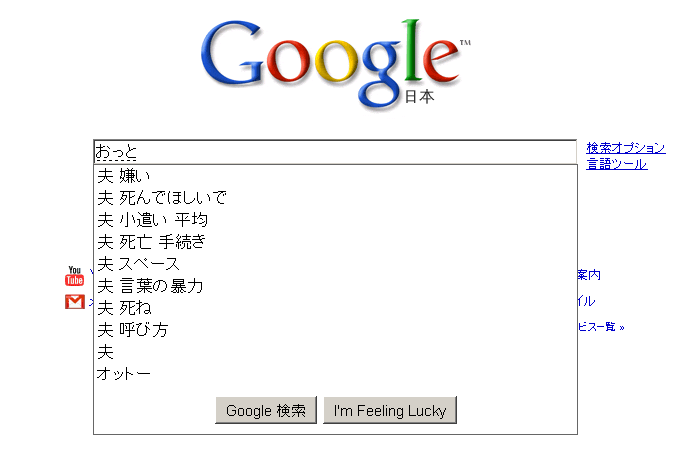Hilarious, isn't it?
Hilarious, isn't it?
I was posed a very trivial question from one of my friends recently. It picked my interest, since I could not readily solve it, and I had the inkling that there is a better, simple solution for this problem.
The problem was, let’s say I have a table of users as below

And these users have friends as below
 or more easier to read as
or more easier to read as 
Now, the trivial task was find common friends for users 1, and 5, hence naturally the answer should be
User 1 : Woody’s friends, and User 5 : Andy’s friends are
 and
and 
So, the question I had was what could be the best SQL query that would be return me this result?

I thought of 2 different SQL queries
SELECT f.fid, u.name 'Woody and Andy\'s common friends' FROM
(SELECT f.`fid` FROM friends f
WHERE f.`uid` IN (1,5)
GROUP BY f.`fid` HAVING COUNT(f.`fid`) > 1) f INNER JOIN user u ON (u.uid=f.fid)
-or- another one was
SELECT f.fid, u.name 'Woody and Andy\'s common friends' FROM
(SELECT a.fid FROM
(SELECT * FROM friends f
WHERE f.`uid`=1) a INNER JOIN
(SELECT * FROM friends f
WHERE f.`uid`=5) b ON (a.fid=b.fid)) f INNER JOIN user u ON (u.uid=f.fid)
Both seem to work, but is there any elegant way of getting common friends in a much simpler SQL query? At this moment, I logically find first SQL query more intuitive since all it does is pickup friends who appear more than once when users are 1 and 5. The second SQL query seems plain brute force approach.
A while ago, I came across an interesting problem. We have 3 different sorted queues (entries were sorted by time), out of which we had to pickup the smallest time, and send the first arrived entry out of those 3 queues in sequence.
| Q1 | Q2 | Q3 |
| 2 | 3 | 1 |
| 5 | 4 | 6 |
| 7 | 6 | 9 |
| 8 | 10 | 11 |
As you can see, all queues (Q1, Q2, Q3) are already sorted, but on application side we have to pickup entries across all queues in sorted order and process them. So the entries should be processed in 1, 2, 3, 4, 5, … 11 sequence. Frankly this is merging of already sorted lists, and a person from computer science background should already know this. But I don’t come from such background, and the solution one of my friends gave was plain amazing.
The solution was pickup first entry from each queue, compare them, choose the smallest and process it first.
| Q1 | Q2 | Q3 | Smallest |
| 2 | 3 | 1 | 1 |
Thus, here 1 is processed first. Now pickup next entry from queue where smallest was found (Q3 in this example), so now the next comparison becomes like this
| Q1 | Q2 | Q3 | Smallest |
| 2 | 3 | 6 | 2 |
The smallest is 2, so this is processed and next entry from Q1 was picked-up
| Q1 | Q2 | Q3 | Smallest |
| 5 | 3 | 6 | 3 |
And so on… giving us
| Q1 | Q2 | Q3 | Smallest |
| 2 | 3 | 1 | 1 |
| 2 | 3 | 6 | 2 |
| 5 | 3 | 6 | 3 |
| 5 | 4 | 6 | 4 |
| 5 | 6 | 6 | 5 |
| 7 | 6 | 6 | 6 |
| 7 | 10 | 6 | 6 |
| 7 | 10 | 9 | 7 |
| 8 | 10 | 9 | 8 |
| 10 | 9 | 9 | |
| 10 | 11 | 10 | |
| 11 | 11 |
A simple, and elegant solution, isn’t it? Is there any other better alternative?
There is no straight (should I say “easy”) way to export Outlook mails to Thunderbird. Using Thunderbird’s import from Outlook did not work since quite a few emails came up as raw HTML, and I had to manually change Automatic encoding detection to OFF, Universal to see the contents each time.
A sure-shot (well… which took me 99% of the) way was Outlook –> Import into Outlook Express –> Import into Thunderbird. This worked, but with one sad issue – non-English attachment names are not as original. If you can live with that, then this is the surest way to go !
Few references which helped-
Import .pst files – MozillaZine KB
String A= "a string";String B= "a string"; will point to same string object on heap.System.gc()finalize method is invoked only once before being removed from memory. Always call super.finalize() if you override it.Very often we are impressed with awe when we see a beautiful picture, photo, advert. The colors, their combination presents an alluring view just right for our eyes. If you notice more closer, you can seeing that more often the colors are complemented (red with white, green with blue…) to give a undistracted overall look. This is essentially because our eyes find this visually pleasant.
I have a tool which can offer such combinations, and you should design your color combinations using the suggested patterns
http://9i9.me/colors/index.html/ – For visually stunning color combinations
Keep working!
See top searches coming from Google for おっと (husband) in Japanese

Almost all top suggestions refer to “husband should die”. I wonder what results are returned?